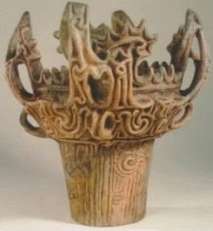As the original image underwent transformation, so did its symbolic significance. Thus, St. George, hardly recognizable as a commoner on horseback slaying a dragon with his spear, was now regarded as the protector of the oppressed. Such frivolous treatment of canonical subjects vexed the senior clergy, who, as a result, banned statues of this kind and insisted on their removal from roadsides and homesteads. Yet they continue to spring up like trees on Lithuanian soil as expressions of the people's aspirations. Wood was also used in other Lithuanian crafts. Various objects, such as peasant clogs, carved vessels, painted chests, distaffs, and other utensils indispensable in the peasant household for centuries, were traditionally made of wood in Lithuania. A popular type of Lithuanian metalwork, the so-called "little suns," decorations for the roofs of houses, originated from the custom of erecting roadside statues. The "little suns" were decorated with exquisitely ham-mered flowers and leaves. The art of folk metalwork declined as manufacturing industries developed, and it was not until recently that it was revived, largely owing to the enthusiasm of present-day smiths. Lithuanian scenery does not display a rich variety of colors. This is reflected in the color scheme of the local homespun or embroidered articles and glazed pottery. The typical geometric ornamentation used in Lithuanian woven or plaited belts is generally formed by two, or sometimes three to four alternating colors. Although the color range appears modest, Lithuanian handloom textiles show a surprising variety of design. Their stylistic austerity testifies to the fact that the Lithuanians based their craft on the artistic language of the remote past. The symbolism of certain ornamental elements is no longer clear, but on the whole the decoration retains its national flavor and vigor. It is for this reason that Lithuanian textiles can be easily distinguished from others. 
|
